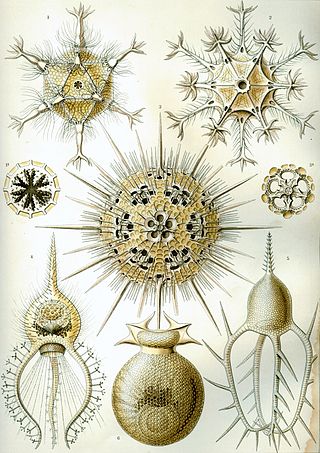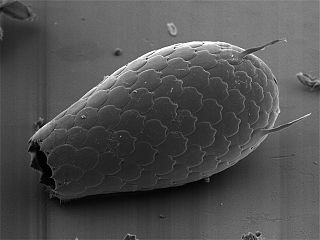
Cercozoa is a phylum of diverse single-celled eukaryotes. They lack shared morphological characteristics at the microscopic level, and are instead united by molecular phylogenies of rRNA and actin or polyubiquitin. They were the first major eukaryotic group to be recognized mainly through molecular phylogenies. They are the natural predators of many species of bacteria. They are closely related to the phylum Retaria, comprising amoeboids that usually have complex shells, and together form a supergroup called Rhizaria.

Phaeodarea or Phaeodaria is a group of amoeboid cercozoan organisms. They are traditionally considered radiolarians, but in molecular trees do not appear to be close relatives of the other groups, and are instead placed among the Cercozoa. They are distinguished by the structure of their central capsule and by the presence of a phaeodium, an aggregate of waste particles within the cell.

Cercomonads are small amoeboflagellates, widespread in aqueous habitats and common in soils.

The tectofilosids are a group of filose amoebae with shells. These are composed of organic materials and sometimes collected debris, in contrast to the euglyphids, which produce shells from siliceous scales. The shell usually has a single opening, but in Amphitrema and a few other genera it has two on opposite ends. The cell itself occupies most of the shell. They are most often found on marsh plants such as Sphagnum.

Monadofilosa is a grouping of Cercozoa. These organisms are single-celled amoeboid protists.

Imbricatea is a class of Rhizaria characterised by silica scales. It is sometimes described as "Imbricatea/Silicofilosea", due to the similarity of those two groupings. Imbricatea is divided into the orders Euglyphida and Thaumatomonadida.

Thecofilosea is a class of unicellular testate amoebae belonging to the phylum Cercozoa. They are amoeboflagellates, organisms with flagella and pseudopodia, distinguished from other cercozoa by their scale-lacking test composed of organic material. They are closely related to the Imbricatea, a group of testate amoebae with tests composed of inorganic silica scales.

Opalozoa is a subphylum of heterotrophic protists of the phylum Bigyra, and is the sister group to Sagenista. Opalozoans are non-photosynthetic heterokonts that are ancestrally phagotrophic but many times have evolved to be osmotrophic saprotrophs in the gut of vertebrate animals.
Proleptomonas is a genus of coprophilic protists, containing the single species Proleptomonas faecicola. It belongs to the phylum Cercozoa, although it was previously considered the only free-living kinetoplastid. It is the only member of family Proleptomonadidae.

Katabia is a genus of soil-dwelling heterotrophic flagellate cercozoans containing the single species Katabia gromovi, and the only member of family Katabiidae.
Leucodictyids are heterotrophic amoeboid protists that comprise the order Leucodictyida in the phylum Cercozoa.
The paracercomonads are a group of cercozoan protists. Taxonomically, they comprise the family Paracercomonadidae, order Paracercomonadida and subclass Paracercomonada. Due to their morphological similarities to the cercomonads, members of this family were grouped with Cercomonas and similar taxa from the beginning. However, their similarities are due to convergent evolution.

Ventrifilosa is a highly diverse group of phagotrophic protists that glide through their flagella and emit filose pseudopods from their ventral side for feeding. Because of their mixture of amoeba and flagellate characteristics, they are amoeboflagellates. Members of this group are the Imbricatea, Sarcomonadea and Thecofilosea.
Cryptofilida is an order of small heterotrophic protists in the phylum Cercozoa. They are filose amoebae that lack cilia and gliding, and are instead characterized by movement through branching or unbranched granular filopodia that are appressed to the substrate during their feeding.
Massisteriidae is a family of granofilosean protists within the phylum Cercozoa.

The glissomonads are a group of bacterivorous gliding flagellated protists that compose the order Glissomonadida, in the amoeboflagellate phylum Cercozoa. They comprise a vast, largely undescribed diversity of soil and freshwater organisms. They are the sister group to cercomonads; the two orders form a solid clade of gliding soil-dwelling flagellates called Pediglissa.
Pediglissa is a subclass of phagotrophic protists that inhabit soil or freshwater habitats. They were defined in 2018 according to phylogenetic analyses that showed a clade containing the orders Cercomonadida and Glissomonadida. They're the sister group of Paracercomonadida.

Viridiraptoridae, previously known as clade X, is a clade of heterotrophic protists in the phylum Cercozoa. They're a family of glissomonads, a group containing a vast, mostly undescribed diversity of soil and freshwater organisms.
Saccharomycomorpha is a genus of non-flagellated protists with a rare yeast-like appearance, containing the single species Saccharomycomorpha psychra. It is the only genus of the family Saccharomycomorphidae, within the cercozoan order Glissomonadida. Before its description in 2021 it was known as clade T, recovered from environmental DNA in previous phylogenetic analyses.

An amoeboflagellate is any eukaryotic organism capable of behaving as an amoeba and as a flagellate at some point during their life cycle. Amoeboflagellates present both pseudopodia and at least one flagellum, often simultaneously.








